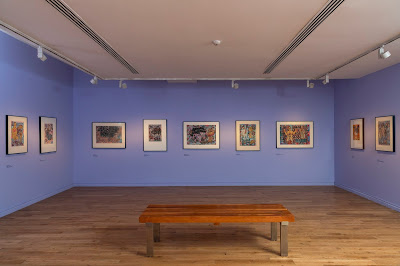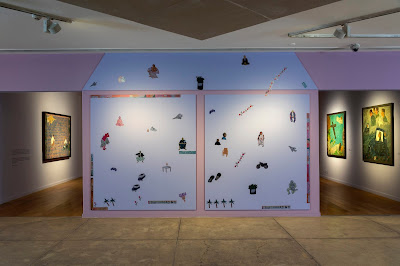#chalomuseum: An art awareness initiative by the KNMA
In an attempt to increase awareness about the museums in our country, the Kiran Nadar Museum of Art (KNMA) has come up with the #chalomuseum campaign. An ongoing initiative it reminds people about the wealth of art and heritage in the country. In an email interview, Smt Kiran Nadar – Founder and Chairperson of Kiran Nadar Museum of Art, Trustee Shiv Nadar Foundation, and Philanthropist shares insights into the museum going culture and the inroads that KNMA is making on the art and culture landscape.
NM: Why do you think Indians do not visit museums within the country and what can be done to address it?
KN: I think there is a lack of awareness of art in India. Through KNMA efforts, we hope to bridge this gap and create a museum going culture in India and prove that art is not only for the elite. Building appreciation in art is a slow process but we hope to energise and invigorate the process using creative methods. I feel that the first step is reaching out to the youth, this is what we have taken on in a large manner. We invite schools to visit the museum, to participate in workshops and attend interesting sessions at our museums. We have such a great art heritage in India; it needs to be highlighted to the public. Additionally, our #chalomuseum campaign is an attempt to spread awareness and encourage the public to visit all the museums in our country, and remind people about the wealth of art and heritage in their own backyard.
KN: I think there is a lack of awareness of art in India. Through KNMA efforts, we hope to bridge this gap and create a museum going culture in India and prove that art is not only for the elite. Building appreciation in art is a slow process but we hope to energise and invigorate the process using creative methods. I feel that the first step is reaching out to the youth, this is what we have taken on in a large manner. We invite schools to visit the museum, to participate in workshops and attend interesting sessions at our museums. We have such a great art heritage in India; it needs to be highlighted to the public. Additionally, our #chalomuseum campaign is an attempt to spread awareness and encourage the public to visit all the museums in our country, and remind people about the wealth of art and heritage in their own backyard.
KN: I started my journey few decades ago as an art collector and have come a long way since then. With the launch of the museum almost a decade ago, we have managed to make great inroads into art education of the youth. I feel that there is an increased level of interest that springs from the young children of today. The adults are a little harder to convince but we hope that through their kids, they will also be able to enjoy and appreciate our vast and wonderful art heritage. My passion lies in raising awareness of the incredible art and culture surrounding us in our nation. I always wanted to create a museum culture in India and prove that art is not a choice of the elite few. Abroad, art is not just for the elite, it is enjoyed by people from all walks of life.
NM: What are the challenges that KNMA faces when it comes to curating art exhibitions and in creating audience engagement?
KN: Kiran Nadar Museum of Art as an institution-builder looks holistically at the ecology of arts in India and the support systems that are needed for contemporary art. Having said that, whatever one might say, exhibitions do tend to happen under different kinds of pressure and productive friction. KNMA did initiate several processes pertaining to curation and bringing the artworks to the readiness required.
In India, Delhi specifically doesn’t have a very interested art scenario unlike Mumbai or Kolkata. Delhi has a large floating population and it takes time for an interest in art to evolve. In India we don’t look at art seriously or as an investment category too. We have realized that art education is the way to engage audiences, therefore we host a number of educational initiatives by collaborating with schools, colleges, NGOS, trusts etc. Screening of films, stimulating curatorial programs, and curated walks form an integral part of the museum’s itinerary, all with the focus of audience engagement. We have recently also tried some out of the box engagement ideas like flash mobs replicating a historical painting, and Heritage Art Project where we set up one day workshops at heritage sites such as Qutab Minar and others across India
NM: What do you feel about the role of private-public partnerships with respect to art museums and its efficacy in the Indian context?
KN: With the comeback of India Pavilion at the Venice Biennale, we have taken a great step forward in terms of private-public partnerships in the sphere of Art. After 8 long years, India once again marked its presence at the art world's oldest Biennale in Venice. As principal partners, KNMA curated the India Pavilion. However, this would not have been possible without the support of the Ministry of Culture, NGMA and CII. We all have come together to make this comeback a huge hit at the Venice Biennale. This in itself is a huge step towards putting India on the International art map, which in turn we hope will help increase awareness and appreciation of art in India itself. Our participation has not come a minute too late and will hopefully continue hereafter. It will bring greater visibility to the artistic talent in India and the comprehension of its diverse, multivalent practice.
Watch the video on #chalomuseum here
All images and video courtesy KNMA
Please share this article using the social media widgets at the bottom and do subscribe to receive regular updates from Art Scene India.
For interviews, profiles, sponsored posts and to contribute articles, contact artsceneinfo@gmail.com
Also read,
- ART COLLECTION: Chitrakala Parishath, Bangalore
- ART COLLECTION: Jaganmohan Palace, Mysore
- ART COLLECTION: NGMA, Bangalore
- 5 Reasons a Good Catalogue Text is Essential for Your Art
- How To Write An Artist Statement
- 6 Tips On How To Approach An Art Gallery And Find Gallery Representation
- Exhibiting Art in Non-Gallery Spaces
- Guide To Exhibiting Your Artworks
- How to Create an Online Presence




